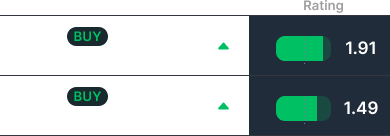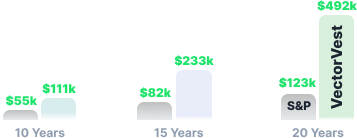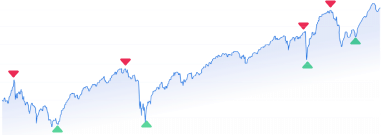Whether you’re just getting started building a stock portfolio from scratch or are looking to diversify your portfolio with safer stocks that deliver steady returns, you need to consider dividend-paying stocks as part of your stock investment strategy.
Wait, what are dividend stocks? More importantly, why are dividend stocks worth it? These stocks return a portion of their profits to shareholders in the form of regular payments. This offers dual benefits: a reliable income stream and the potential for stock value appreciation.
You can learn more about these types of stocks below, including how to get started investing in stocks that pay dividends yourself. No matter your investment approach, VectorVest can streamline the process through our stock analysis software that tells you what to buy, when to buy it, and when to sell it.
Leverage the best stock picker today and effortlessly uncover winning opportunities on autopilot, execute trades with precision, and manage your portfolio without stress and uncertainty!
What Are Dividend Stocks?
Let’s start with the basics – what are dividend stocks? As we said from the start these represent shares in companies that distribute a portion of their earnings back to shareholders.
Companies pay dividends to attract and retain investors by providing a steady income alongside potential market value gains. These payouts can vary in frequency but are most commonly distributed quarterly. Some companies also offer monthly, semi-annual, or annual dividends.
The decision to pay dividends, the amount, and the frequency reflect the company’s current financial health and future growth prospects.
Typically, well-established companies with consistent profit streams are the most likely to offer regular dividends. That being said, there are a few types of companies that most often pay dividends…
Types of Publicly Traded Companies That Pay Dividends
You’ll generally see mature, revenue-generating companies in stable industries pay out dividends. These include utility companies, consumer goods companies, real estate investment trusts (REITs), and financial institutions.
Such companies usually have less need for extensive capital reinvestment compared to high-growth industries, allowing them to distribute a portion of their profits to shareholders.
On the other hand, aggressive growth stocks will not pay dividends most of the time. Any profits from these companies are put directly back into the business to fuel future prospects. These companies consist of tech startups or companies in capital-intensive sectors like biotechnology.
That’s not to say that these types of high volatility stocks aren’t worth investing in too – it all comes down to balance and diversification.
We have a separate guide comparing and contrasting dividend vs growth stocks, and we’ll talk about this more later on. First, we need to provide an overview of the dividend payout process.
Understanding the Dividend Payout Process
Now, how often do dividend stocks pay? It all depends. If you’re going to invest in dividend-paying stocks it’s important that you understand the key dates and the process behind the payout:
- Declaration Date: The date on which the board of directors announces an upcoming dividend payment, specifying the dividend amount and the payment schedule.
- Ex-Dividend Date: Investors must purchase the stock before this date to receive the declared dividend. Anyone buying the stock on or after the ex-dividend date will not receive the dividend for that payment cycle.
- Record Date: This is the date on which the company reviews its records to determine the shareholders eligible for the dividend payment.
- Payment Date: The actual date on which the dividend payment is made to the shareholders listed as of the record date.
What Are the Benefits of Investing in Dividend Stocks?
You may already be starting to see some of the advantages of this type of investment…but what are dividend stocks going to bring to your portfolio beyond the regular dividend payout? We’ll cover all the benefits of blue chip investing with dividend stocks below.
Steady Income Stream
One of the most powerful strategies is being able to live off dividends in retirement. Retirees can generate consistent cash flow without needing to sell their shares to supplement income.
Unlike traditional investments, you more or less know what you can expect from a dividend payout schedule too. Companies may adjust their dividend yield slightly on a quarterly or annual basis, but you can accurately forecast your income through dividend stocks, allowing you to budget for expenses or reinvest the dividends more strategically.
Compounding Returns Through Reinvestment
The real advantage of dividend investing comes in the form of compounding returns through reinvestment. This is known as a dividend reinvestment plan (DRIP).
You can dramatically increase the value of your initial principle over time by automatically reinvesting dividends to purchase additional shares.
This not only grows the number of shares owned but also increases the potential dividend payout for each subsequent period, accelerating the compounding effect.
Portfolio Stability
While no investment strategy is without risk, dividend-paying stocks are regarded as safer and less volatile than those that don’t pay a dividend. This is because companies that can afford to pay dividends regularly are typically well-established and financially stable, contributing to lower price volatility.
Including dividend stocks in an investment portfolio can help reduce overall risk through diversification and provide a buffer during market downturns.
When stock prices fall, the dividend yield (the dividend as a percentage of the stock price) increases, which can help offset some of the price declines and offer a return on investment in the form of dividend income.
Is There Any Downside to Investing in Dividend Paying Stocks?
Now, it’s important to be aware of both sides of the coin and understand the tradeoffs of investing in dividend stocks as opposed to high growth opportunities. Here are some considerations when investing in these types of stocks.
The Trade-off Between High Yield and Growth
Investing heavily in dividend-paying stocks often means sacrificing potential capital gains. Companies that pay high dividends may not reinvest much of their profits back into the business, which can limit their growth opportunities.
As a result, these stocks might not appreciate in value as rapidly as growth stocks, particularly those in emerging sectors or technologies. If you need significant asset appreciation you might find the returns from high dividend yields insufficient.
Understanding the Tax Treatment of Dividends
Dividend income is taxed differently than capital gains in many jurisdictions, which can be a good or bad thing depending on the type of dividend and your tax scenario.
For example, qualified dividends are taxed at the capital gains tax rate in the United States, which is lower than the ordinary income tax rate. However, non-qualified dividends are taxed as ordinary income.
The distinction between these categories and the varying tax rates can affect your net income from dividend investments, potentially making them less attractive depending on your tax situation.
Concerns of Dividend Cuts and Suspensions
Despite the fact that dividend-paying stocks are safe, established companies, it’s not uncommon for a company to cut or even suspend its dividend payouts altogether. This can occur due to economic downturns or if a company faces financial difficulties.
Such cuts or suspensions are often seen in industries that suffer from cyclicality or operational issues. The impact of losing a significant income source can be severe for investors who rely heavily on dividends for income.
This can be a double-edged sword, too. Share prices tend to tank when a dividend cut or suspension is announced as a result of negative investor sentiment. You can be stuck cutting losses if you aren’t able to get out in time.
Tips on Dividend Investing for Beginners
If you decide that this strategy aligns with your goals as an investor, you’re in luck. We have tips on how to pick a stock that pays dividends and manage a thriving portfolio below. The best part? All of this can be streamlined when you use the best stock analysis app: VectorVest.
How to Identify Strong Dividend Stocks
A strong dividend stock doesn’t just have a solid yield but also a stable history of meeting dividend payments. The best stocks to buy for beginners are those representing companies with a long track record of stable or increasing dividend payments. You can find this information on many free stock analysis websites.
You should also look beyond the yield and history of a company’s dividend and assess its payout ratio. This speaks to the percentage of earnings paid out as dividends. A payout ratio that is too high, typically above 80%, may not be sustainable in the long run.
Remember, earnings drive the market – so look for strong earnings growth, as this supports continued dividend payouts and potential increases.
You can learn fundamental analysis in our blog, including how to do fundamental analysis of stocks, how to combine fundamental and technical analysis, or better yet, how to use our stock fundamental analysis tool to save time and stress while winning more trades.
Balancing High and Low Yield Stocks
While high-yield stocks can be attractive for their immediate income potential, they often come with higher risks and may indicate that the dividend is not sustainable.
On the other hand, stocks with lower yields but consistent growth in dividends may offer better long-term security and potential for capital appreciation.
Beginners should create a balanced portfolio that includes both types of stocks to optimize income while managing risk. This strategy ensures that you benefit from immediate returns and enjoy growth in income over time.
Investing in Dividend-Based Funds and ETFs
If you don’t have the time or expertise to analyze stocks individually, investing in dividend-paying mutual funds or ETFs can be a smart alternative. These aggregate many dividend stocks, providing instant diversification and reducing the risk associated with individual securities.
Just as you would in vetting individual stocks, consider factors like the fund’s performance history, its expense ratio, and its dividend yield compared to similar funds.
You should also review the fund’s focus on particular sectors or regions, as this can affect performance depending on market conditions.
That being said, you may find that your returns are lower through a fund, as any fund is going to have its fair share of losing companies. You’re better off leveraging the best investment app for beginners to gain clear, actionable insights and execute trades with confidence. Here’s how VectorVest can help you get started on the right foot…
Using VectorVest to Find Winning Opportunities on Autopilot
VectorVest is a proprietary stock trading system that takes complex technical data and transforms it into simple insights so you can spend less time in front of your screen while winning more trades.
It’s outperformed the S&P 500 index by 10x over the past 22 years and counting. The system works through 3 ratings:
- Relative value (RV): Compares a stock’s long-term price appreciation potential (forecasted 3 years out), AAA corporate bond rates, and risk. It’s a far superior indicator than the typical comparison of price to value alone.
- Relative safety (RS): Computed through an analysis of the company’s financial consistency & predictability, debt-to-equity ratio, business longevity, sales volume, and price volatility.
- Relative timing (RT): Based on the direction, dynamics, and magnitude of the stock’s price movement day over day, week over week, quarter over quarter, and year over year.
Each rating sits on a scale of 0.00-2.00 with 1.00 being the average, making your analysis quick and easy. Just pick safe, undervalued stocks rising in price to win more trades!
Better yet, pull up our daily stock picks and find the top dividend stocks on any given day. We scan 16,000+ stocks daily to keep you at the cutting edge of the market.
You never have to wonder about when to buy stocks or when to sell stocks either, as the system helps you manage your portfolio with confidence. You’re offered a clear buy, sell, or hold recommendation for any stock in your portfolio at any given time!
It isn’t just great for finding the best blue chip dividend stocks, though. You can also find falling stocks to buy, current undervalued stocks, the best stocks to swing trade, the best stocks to day trade, and anything in between.
So, whether you’re looking for the best stock apps for iPhone or the best stock apps Android, give VectorVest a try and see how simple investing in dividend-paying stocks can be. A free stock analysis is just a few clicks away!
What are Some Dividend Stocks Worth Investing in Today?
Now, what are dividend stocks worth investing in today? We encourage you to always check for the latest updates on the best stock research site – VectorVest – before making your decision. That being said, here are some of the top performers in 2024:
- McDonald’s: This staple in the fast-food industry has shown resilience over the decades and boasts a market cap of $211.8 billion, reflecting its substantial industry footprint and consumer base. It offers a current yield of 2.13%, backed by a robust history of steady dividend growth.
- JP Morgan Chase & Co.: Valued at $517.66 billion, this behemoth in the financial sector provides a stable, diverse investment with a yield of 2.29%, appealing to those looking for steady income from financial sector investments.
- AT&T Inc.: This company is heavily invested in the expansion of its 5G and fiber networks, aiming to secure its position as a leader in telecommunications. It has a market cap of $121.3 billion and a high yield of 6.54%.
- Apple Inc.: A leader in technology with a massive market cap of $2.8 trillion. Its products and services are integral to tech consumers worldwide, and this is one of those companies you just never bet against. Although its yield is 0.52%, the company’s growth potential and financial stability make it a compelling choice for tech-savvy investors.
- Microsoft Corporation: Its extensive portfolio, including cloud computing, software development, and artificial intelligence support a modest yet growing dividend at 0.69% backed by a $3 trillion market cap. Similar to Apple, the appeal here is that you can get steady dividends along with stock growth gains.
These companies represent a cross-section of industries and are characterized by their ability to generate consistent cash flow, maintain financial health, and offer strategic growth opportunities. There are many more where these came from, so get set up with VectorVest today and find the best dividend-paying stocks on autopilot!
Bringing our Beginner’s Guide on Dividend Paying Stocks to a Close
That brings our guide on dividend-paying stocks to a close. In summary, what are dividend stocks? These represent established companies that return a portion of profits to shareholders. They offer dual benefits of a steady income and the potential for capital appreciation.
Hopefully, you have a clear understanding about the role these can play in your investment strategy and how to go about capitalizing on them.
You can learn more about the best stock indicators, how to buy the dip, investing after retirement, buying and selling stocks the same day, the best day of the week to buy stocks, fundamental vs technical analysis, and more.
Otherwise, it’s time to transform your trading strategy for the better with VectorVest today. Our stock advisory helps you find opportunities that align with your goals while empowering you to execute trades with precision and confidence.
Start your VectorVest subscription today and experience the difference firsthand!
What you should do next…
- Get our latest blogs delivered right to your inbox, subscribe to our newsletter.
- The market moves fast! Get our most current evaluation of this stock with our FREE stock analysis tool.
- Looking for stock picks? Not sure if now is the right time to buy/sell? For a limited time, enjoy the full benefits of a 30-day subscription to VectorVest for only [offer_txt] (usually up to [saving_txt]/month) . Get access to our full list of screeners showcasing our top stock picks that tell you exactly what to buy, when to buy, and when to sell.












